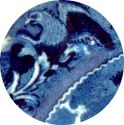Joseph Stubbs
|
Joseph, son of Benjamin Stubbs was baptized September, 1786. The first we hear of him as a potter is as partner with John Taylor in 1816[i] followed shortly by the dissolution of the partnership in March, 1817, with Stubbs taking responsibility for settling outstanding accounts.[ii] The dissolution may have been hastened by Joseph Stubbs joining a business in America in 1816. In early October, 1816, letters awaited him at the Post Office in Boston, and on October 24, 1816 the Boston Daily advertiser announced, COPARTNERSHIP ... SWIFT & ANDREWS inform their Friends and customers that they have formed a connexion with Mr. Joseph Stubbs of Staffordshire, England for the purpose of extending their business in manufacturing and importing China, Glass and Crockery Ware. Their business will in future be transacted under the firm of ANDREWS, STUBBS & CO. The partnership lasted less than 3 months and on January 8, 1817 Andrews and Swift used the same newspaper to announce the dissolution. There are subsequent newspaper reports of crates of earthenware being shipped to a Joseph Stubbs in Boston and Philadelphia, and finally in July 1820 an advertisement in New York of earthenware for sale by Joseph Stubbs.[iii] While these last references may be a coincidence of name, it seems very likely that the partnership and dissolution in 1816-17 referred to Joseph Stubbs whose products included dark blue printed earthenware with American themed designs. Meanwhile, back in Staffordshire,
following the Stubbs-Taylor partnership dissolution, Benjamin Stubbs is listed
as a potter in Longport in 1818, perhaps maintaining the business for his son
Joseph, who is notably absent from the two directories published in that year.[iv]
It is possible that Benjamin Stubbs established a partnership with his son, and
financed him in the pottery business. But with Joseph’s absence in America and
Benjamin’s involvement in other business ventures, they would have needed the support
of an experienced pottery manager. Of the two directories published in 1822, Pigot & Co printed in June, 1822, lists
Benjamin Stubbs at Longport, whereas Allbut’s Directory 1822-23 lists Joseph
Stubbs at Longport suggesting that Joseph had returned from America and assumed
control of the business sometime in mid-1822. [v] It’s not clear when, and under what circumstances, the factory used the linear impressed mark “STUBBS” or the circular impressed marks “JOSEPH STUBBS LONGPORT” and “STUBBS & KENT LONGPORT”. The single name STUBBS could have been used at any time from the founding of the business by Benjamin Stubbs in 1818 to the company’s closure. As Joseph Stubbs was perhaps the practical potter and was on site, he may have used his own mark alongside that of the partnership with Kent. The matter is problematic as, even after Kent’s death in 1828, the business continued to be listed as Stubbs & Kent through at least 1830,[viii]the ending of the partnership and the closing of the estate undoubtedly being complicated by the sudden demise of the younger partner and his dispatch at sea. In 1834, declining business because of ill-health, Joseph Stubbs advertised the auction of his engravings, molds, etc.,”suitable for the American and home trade”. It was a bad time for business in the Potteries with a period of industrial unrest and strikes, and Joseph was still listed as a potter in Longport in 1835.[ix] But the following year, at the age of 50 he died from complications following surgery.[x] In his will he left £5,000 to his cousin Hannah Walker and the rest of his estate to “his dear wife Sarah Stubbs”.[xi] By 1836 the factory had been let to Thomas Mayer, and Mr. & Mrs. Mayer moved into the adjacent house when Sarah Stubbs moved out in 1838. [i] Thomas Underhill, Biennial directory, class third …. in England, Ireland, Scotland, and Wales … the whole alphabetically arranged, with a copious index. London : Printed for the proprietor, 1816. [ii] Staffordshire Advertiser, March 22, 1817. See Hampson, Rodney. 2000. Pottery References in the Staffordshire Advertiser 1795- 1860. Kendal, Cumbria, Northern Ceramic Society. [iii] P.P.F. DeGrand’s Boston Weekly Report, November 6, 1819 & July 15, 1820; Grotjan's Philadelphia Public Sale Report; November 8,1819; Poulson's American Daily Advertiser, September 14,1820; New-York Gazette & General Advertiser, May 19 & May21, 1821. [iv] W. Parson & T. Bradshaw, Staffordshire General & Commercial Directory, 1818; Pigot, J. Commercial Directory, for 1818-19-20. Manchester, James Pigot. 1818. [v] Allbut, T. The Newcastle and Pottery General and Commercial Directory, for 1822-23. Hanley, T. Allbut. 1822; Pigot, J.& Co. Pigot & Co.’s London & Provincial New Commercial Directory, for 1822-3. Manchester, J. Pigot & Co. 1822. [vi] Passenger list of the James Cropper, Ancestry.com; New York Spectator, June 26, 1804 [vii] New York Spectator, May 6, 1828 [viii] J. Pigot, Pigot & Co.’s National Commercial Directory, 1828 & 1830 [ix] J. Pigot, Pigot & Co.’s National Commercial Directory, 1835 [x] Monument St. Paul’s Church, Burslem [xi] United Kingdom National Archives, Catalogue Reference:Prob 11/1879 |
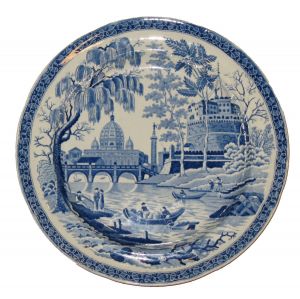 Blue printed plate 'Rome' patternimpressed STUBBSWinterthur Museum 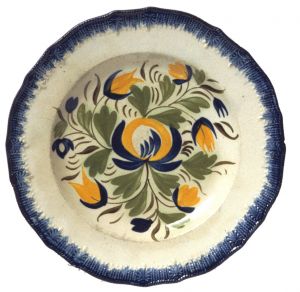 Blue edged and painted pearlware plate impressed mark of Stubbs & KentWinterthur Museum 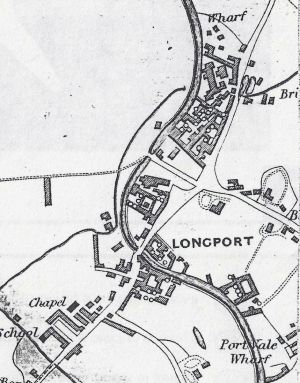 Plan of Longport showing pottery factories.Hargreaves Map, 1832 Plan of Longport showing pottery factories.Hargreaves Map, 1832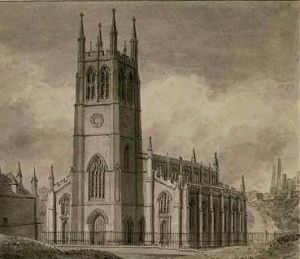 St. Paul's Church, Longport, Burslem. St. Paul's Church, Longport, Burslem. note the pottery ovens, in the distance. |

